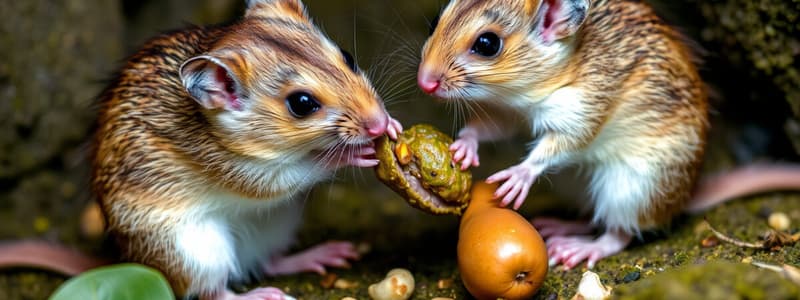Podcast
Questions and Answers
What method do mice NOT use for communication?
What method do mice NOT use for communication?
- Visual signals (correct)
- Vocalizations
- Scent markings
- Body language
Which characteristic is true regarding the territorial behavior of male mice?
Which characteristic is true regarding the territorial behavior of male mice?
- They are less territorial than females.
- They share their territory more often than females.
- They establish territories to secure resources. (correct)
- Territoriality is not important for male mice.
What is the primary purpose of playful behavior in young mice?
What is the primary purpose of playful behavior in young mice?
- To show dominance over other mice
- To find food
- To attract mates
- To develop social skills (correct)
How do mice typically respond to threats?
How do mice typically respond to threats?
Which of the following statements about a mouse's grooming behavior is correct?
Which of the following statements about a mouse's grooming behavior is correct?
Flashcards are hidden until you start studying
Study Notes
Behavior of Mice
-
Social Structure
- Mice are highly social animals, often living in groups.
- They communicate through vocalizations, scent markings, and body language.
-
Territoriality
- Mice establish territories to secure resources.
- Male mice tend to be more territorial than females.
-
Foraging and Feeding
- Mice are omnivorous, feeding on seeds, fruits, grains, and insects.
- They exhibit foraging behaviors, often hoarding food for later consumption.
-
Nesting Habits
- Mice build nests using materials like shredded paper, grass, and fabric.
- Nests are constructed in hidden areas to provide safety from predators.
-
Reproduction
- Mice are prolific breeders, with females capable of producing several litters per year.
- Parental care is provided by the mother, who nurses and protects the young.
-
Grooming and Hygiene
- Mice engage in regular grooming to maintain cleanliness and remove parasites.
- Grooming behaviors are also important for social bonding.
-
Exploration and Play
- Young mice exhibit playful behaviors, which are crucial for development.
- Mice are naturally curious and will explore new environments cautiously.
-
Stress Responses
- Mice show signs of stress through increased grooming, vocalizations, or aggression.
- They may hide or freeze when threatened.
-
Learning and Memory
- Mice demonstrate the ability to learn from experiences and remember environmental cues.
- They can be trained to navigate mazes and perform tasks for rewards.
Social Structure
- Mice thrive in social environments, typically forming groups for companionship and security.
- Communication occurs through vocal sounds, scent-marking, and body language.
Territoriality
- Territories are established by mice to protect and secure essential resources like food and nesting sites.
- Male mice tend to display stronger territorial behaviors than their female counterparts.
Foraging and Feeding
- Mice are omnivores, eating a varied diet that includes seeds, fruits, grains, and insects.
- They often exhibit foraging strategies, which include hoarding food for future use during times of scarcity.
Nesting Habits
- Nests are constructed in concealed areas using materials such as shredded paper, grass, and fabric to ensure safety from predators.
- This hidden construction provides a secure environment for raising young and storing food.
Reproduction
- Females are capable of producing multiple litters throughout the year, making mice highly prolific breeders.
- Maternal care is vital, as mothers nurse and protect their young from dangers.
Grooming and Hygiene
- Regular grooming is essential for mice to maintain cleanliness while eliminating parasites.
- Grooming also serves a social function, facilitating bonding among group members.
Exploration and Play
- Juvenile mice exhibit playful behaviors fundamental for their growth and development.
- Mice possess a natural curiosity, approaching new environments with cautious exploration.
Stress Responses
- Stress manifestations in mice can include increased grooming, vocalizations, or aggressive behavior.
- In threatening situations, mice may hide or freeze as a survival instinct.
Learning and Memory
- Mice have shown impressive learning capabilities, adapting their behaviors based on previous experiences.
- Training can involve navigating mazes and performing tasks for rewards, highlighting their cognitive skills.
Studying That Suits You
Use AI to generate personalized quizzes and flashcards to suit your learning preferences.




